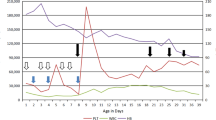Abstract
Takenouchi-Kosaki syndrome (TKS) is a rare congenital disease caused by a de novo heterozygous mutation in the CDC42 gene. Its characteristic clinical features are macrothrombocytopenia, developmental delay, dysmorphic facial features, and deafness. Splenectomy has been contraindicated for inherited thrombocytopenia, and there is little information on treatment of macrothrombocytopenia in TKS. In a previously reported case of autoimmune hemolytic anemia (AIHA) with TKS, we observed that AIHA initially resolved with prednisolone, but gradually became refractory to drug therapy. After splenectomy, both anemia and macrothrombocytopenia improved. This is a novel positive effect of splenectomy for thrombocytopenia in TKS, although further studies are required to assess the effectiveness and safety of splenectomy.


Similar content being viewed by others
Data availability
The data of the findings of this study are available on request from the corresponding authors. The data are not publicly available since the information could compromise the privacy of research participants.
References
Takenouchi T, Okamoto N, Ida S, Uehara T, Kosaki K. Further evidence of a mutation in CDC42 as a cause of a recognizable syndromic form of thrombocytopenia. Am J Med Genet A. 2016;170A:852–5.
Takenouchi T, Kosaki R, Niizuma T, Hata K, Kosaki K. Macrothrombocytopenia and developmental delay with a de novo CDC42 mutation: yet another locus for thrombocytopenia and developmental delay. Am J Med Genet A. 2015;167A:2822–5.
ClinVar database. CDC42[symbol]. https://www.ncbi.nlm.nih.gov/clinvar/?gr=1&term=CDC42[sym]. Accessed 2 Oct 2022.
Motokawa M, Watanabe S, Nakatomi A, Kondoh T, Matsumoto T, Morifuji K, et al. A hot-spot mutation in CDC42 (p.Tyr64Cys) and novel phenotypes in the third patient with Takenouchi-Kosaki syndrome. J Hum Genet. 2018;63:387–90.
Uehara T, Suzuki H, Okamoto N, Kondoh T, Ahmad A, O’Connor BC, et al. Pathogenetic basis of Takenouchi-Kosaki syndrome: electron microscopy study using platelets in patients and functional studies in a Caenorhabditis elegans model. Sci Rep. 2019;9:4418.
Ishikawa K, Uchiyama T, Kaname T, Kawai T, Ishiguro A. Autoimmune hemolytic anemia associated with Takenouchi-Kosaki syndrome. Pediatr Int. 2021;63:1528–30.
Lam MT, Coppola S, Krumbach OHF, Prencipe G, Insalaco A, Cifaldi C, et al. A novel disorder involving dyshematopoiesis, inflammation, and HLH due to aberrant CDC42 function. J Exp Med. 2019;216:2778–99.
Daimon E, Shibukawa Y, Thanasegaran S, Yamazaki N, Okamoto N. Macrothrombocytopenia of Takenouchi-Kosaki syndrome is ameliorated by CDC42 specific- and lipidation inhibitors in MEG-01 cells. Sci Rep. 2021;11:17990.8.
Noris P, Pecci A. Hereditary thrombocytopenias: a growing list of disorders. Hematology Am Soc Hematol Educ Program. 2017;2017:385–99.
Quartier P, Brethon B, Philippet P, Landman-Parker J, Le Deist F, Fischer A. Treatment of childhood autoimmune haemolytic anaemia with rituximab. Lancet. 2001;358:1511–3.
Aladjidi N, Leverger G, Leblanc T, Picat MQ, Michel G, Bertrand Y, et al. New insights into childhood autoimmune hemolytic anemia: a French national observational study of 265 children. Haematologica. 2011;96:655–63.
Eto K, Kunishima S. Linkage between the mechanisms of thrombocytopenia and thrombopoiesis. Blood. 2016;127:1234–41.
Pleines I, Eckly A, Elvers M, Hagedorn I, Eliautou S, Markus B, et al. Multiple alterations of platelet functions dominated by increased secretion in mice lacking CDC42 in platelets. Blood. 2010;115:3364–73.
Abdul-Manan N, Aghazadeh B, Liu GA, Majumdar A, Ouerfelli O, Siminovitch KA, et al. Structure of Cdc42 in complex with the GTPase-binding domain of the “Wiskott-Aldrich syndrome” protein. Nature. 1999;399:379–83.
Martinelli S, Krumbach OHF, Pantaleoni F, Coppola S, Amin E, Pannone L, et al. Functional dysregulation of CDC42 causes diverse developmental phenotypes. Am J Hum Genet. 2018;102:309–20.
Lum LG, Tubergen DG, Corash L, Blaese MR. Splenectomy in the management of the thrombocytopenia of the Wiskott-Aldrich syndrome. N Engl J Med. 1980;302:892–6.
Glasmacher JS, Bittner TC, Ochs HD, Aiuti A, Arkwright PD, Balashov D, et al. Wiskott-Aldrich syndrome: a retrospective study on 575 patients analyzing the impact of splenectomy, stem cell transplantation, or no definitive treatment on frequency of disease-related complications and physician-perceived quality of life. Blood. 2016;128:366.
Acknowledgements
The authors would like to thank the medical editor from the Division of Postgraduate Education and Training at the NCCHD for editing a draft of this manuscript.
Funding
This study was supported by grants from the Japan Agency for Medical Research and Development (18ek0109366h0001, 19ek0109366h0002, and 20ek0109366h003), and a grant from NCCHD (2021-B3) to A. Ishiguro.
Author information
Authors and Affiliations
Contributions
AI (both Iguchi and Ishiguro), TU, and SK contributed to the conception and supervised the study; TK and KY performed genetic analysis; SY and KI drafted the manuscript and figures with contributions from both AIs and AS. All authors reviewed and approved the final manuscript.
Corresponding author
Ethics declarations
Conflict of interest
The authors declare no conflicts of interest associated with this manuscript.
Ethical approval
This study was approved by the Ethics Committees of the NCCHD in May 2018 (#1818). Informed consent for this report was obtained from the patient and her parents.
Additional information
Publisher's Note
Springer Nature remains neutral with regard to jurisdictional claims in published maps and institutional affiliations.
About this article
Cite this article
Yamano, S., Iguchi, A., Ishikawa, K. et al. Splenectomy as an effective treatment for macrothrombocytopenia in Takenouchi-Kosaki syndrome. Int J Hematol 117, 622–625 (2023). https://doi.org/10.1007/s12185-022-03491-w
Received:
Revised:
Accepted:
Published:
Issue Date:
DOI: https://doi.org/10.1007/s12185-022-03491-w




